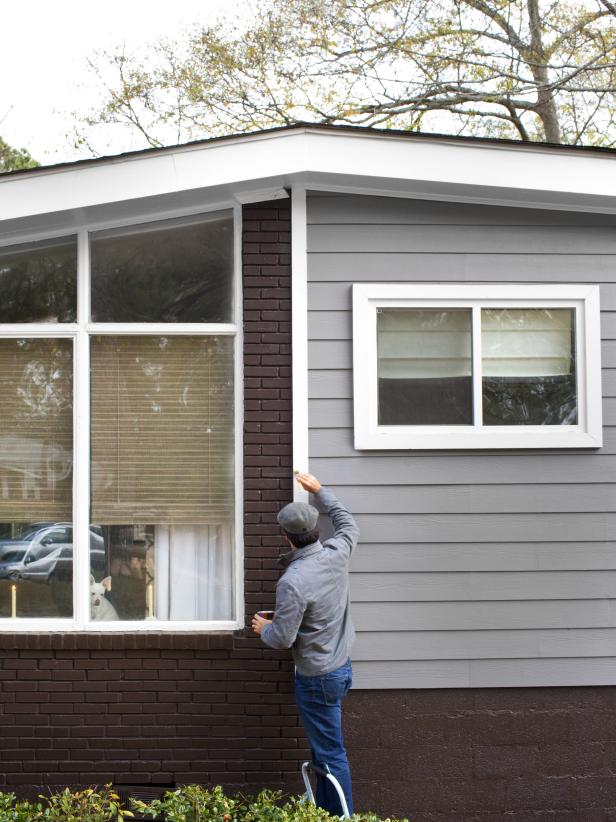How to Properly Paint Your Home’s Exterior
Time always seems to be too short. So, if you choose to paint your own house instead of hiring professional house painters, you'll probably benefit from time-saving tips. These are hacks, tips, and recommendations that can help you paint your house efficiently, effectively, and with less effort.

Safety Considerations
When painting the exterior of your house there are several safety factors you should take into consideration. For starters, make sure you are using the correct ladder and that it is stable. You might even want someone to spot you as you climb to the highest parts of the house.
Take note of the power lines and where they intersect regarding to your property and roof line. You can take extra precautions and ask the power company to turn off the power, but that isn't necessary. Do not use an aluminum ladder if there are wires near your home.
When you have run out of paint or are done with the job, dispose of paint cans properly. Check to see your town or city's waste disposal programs and find a drop-off center to safely dispose of the paint. Save any extra paint in an air-tight sealed container for touch-ups.
Start Painting at the Right Time
What's the best time to start painting? First thing in the morning? Late in the afternoon?
As it turns out, the best time to paint a house is as early as possible, but not so early that dew or other moisture is still on the house siding. Accumulated moisture remaining from the previous night will cause streaks and poor adhesion, prompting you to go back and touch up the flaws.
Make sure that temperatures have risen to 35 degrees F or more, depending on the type of paint you are using. But don't wait too long. When the siding heats up, it will prematurely cure the paint—another condition that will require you to go back and fix it.
Wash the House Quickly:max_bytes(150000):strip_icc():format(webp)/wash-185280448-58dbd57e3df78c516213029f.jpg)
Most houses will need to be washed down before painting. Washing a house by hand is the most effective and the most work-intensive method. What's faster?
If you own a pressure washer, spray down the house two times. First, clean it with a soapy solution. Second, rinse it with clean water. If you have no pressure washer, your next-best option is to thoroughly hose down the house, supplemented by scrubbing with a nylon brush in key areas.
Use the Same Color Paint:max_bytes(150000):strip_icc():format(webp)/house-painter-157329407-58dbd74a5f9b584683d2ddb8.jpg)
While changing the exterior house color is fun—and often, the sole reason for painting the house—it significantly increases the amount of work and slows down the project. If you want to change the color, then consider making the next color darker than the present color.
Minimize Priming
:max_bytes(150000):strip_icc():format(webp)/ladders-resting-against-old-house-200267615-001-58dbd7a55f9b584683d30803.jpg)
Does your house need a complete coat of primer before applying the paint? When the paint is in good condition and you are re-painting the same color, there should be no need to apply primer.Bare wood, wood filler, and rust-stained areas should all be primed. If you just have a few bare patches, one quart of exterior-grade primer should be enough. Prime only the unpainted and unprimed areas with primer, not the whole house.
Minimize Paint Scraping:max_bytes(150000):strip_icc():format(webp)/cropped-hand-of-man-scraping-paint-on-wall-at-home-660573931-58dbd8353df78c51621346b2.jpg)
Scraping paint is a universally unloved subset of painting. After scraping paint for a couple of hours, you will long for the comparatively easier jobs of brushing, rolling, or spraying.
One problem with paint scraping is that one section always seems to lead to another. If the edges of the paint will stay down, you can probably leave it alone. The new paint will seal the edges and help keep it in place. Scrape until you reach a relatively solid edge, then stop at that edge.
If you find that you need to remove all of the paint from the house, it is time to hire house painters or a crew to mechanically remove the paint.
Use a Paint Roller:max_bytes(150000):strip_icc():format(webp)/house-painter-rolling-siding-trim-board-184322768-58dbd8533df78c5162134f7f.jpg)
Paint rolling lets you cover large expanses fast. The catch is that many types of siding do not lend themselves to rolling. Shiplap siding, for instance, is difficult to paint with a paint roller (wide shiplap, though, can be painted with a roller).
If your house has flat siding or even large flat sections, use a paint roller and an extension pole to cover those sections quickly.
Use a Paint Sprayer:max_bytes(150000):strip_icc():format(webp)/painter-on-white-background-150377826-58dbd94b5f9b584683d4fe1a.jpg)
Paint spraying allows you to quickly and efficiently cover large areas or areas that have lots of details.
Paint spraying means that all non-paintable surfaces within 20 feet should be covered. Cover bushes, small trees, and grass.
If your house is rich in architectural details, the time invested in paint spraying will pay for itself many times over. Details usually mean brushwork, and brushwork is always slow. But if you are able to mask away non-painted areas without undue time or effort, this is highly recommended.
Minimize Cleaning:max_bytes(150000):strip_icc():format(webp)/paint-equipment-172249479-58dbd9815f9b584683d55600.jpg)
After a long day of painting, the last thing you want to do is clean up your brushes and roller covers. But cleaning is an essential step in keeping your painting tools around for a long time and in good condition.
For paint roller covers, purchase inexpensive quality roller covers and dispose of them at the end of each painting session. Exterior painting is conducive to economy-quality roller covers. Or clean paint rollers by submerging the roller in warm water, plus a few drops of mild dish soap. Wearing waterproof gloves, squeeze out the paint underwater. Then, rinse several times in clean water.
Buy high-quality brushes and treat them well. Clean good brushes with a paintbrush comb and a continuous flow of water, like from a hose or a sink. Paintbrush combs cut brush clean-up time by pulling out all of the paint remaining between the bristles.
:max_bytes(150000):strip_icc():format(webp)/Man-Painting-House-Exterior-519515491-56a4a0e13df78cf772835201.jpg)